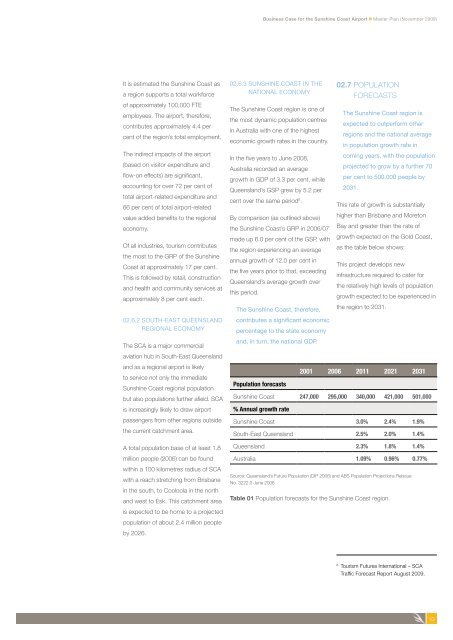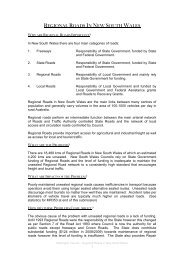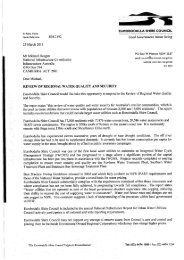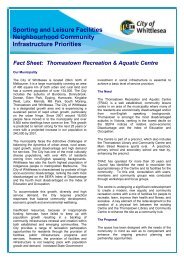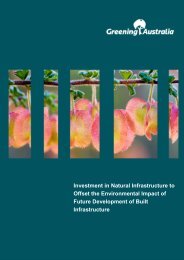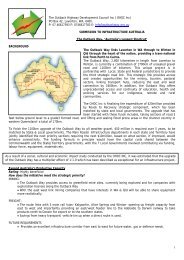Business Case for the SunShine CoaSt airport Master Plan
Business Case for the SunShine CoaSt airport Master Plan
Business Case for the SunShine CoaSt airport Master Plan
Create successful ePaper yourself
Turn your PDF publications into a flip-book with our unique Google optimized e-Paper software.
<strong>Business</strong> <strong>Case</strong> <strong>for</strong> <strong>the</strong> Sunshine Coast Airport n <strong>Master</strong> <strong>Plan</strong> (November 2009)<br />
It is estimated <strong>the</strong> Sunshine Coast as<br />
a region supports a total work<strong>for</strong>ce<br />
of approximately 100,000 FTE<br />
employees. The <strong>airport</strong>, <strong>the</strong>re<strong>for</strong>e,<br />
contributes approximately 4.4 per<br />
cent of <strong>the</strong> region’s total employment.<br />
The indirect impacts of <strong>the</strong> <strong>airport</strong><br />
(based on visitor expenditure and<br />
flow-on effects) are significant,<br />
accounting <strong>for</strong> over 72 per cent of<br />
total <strong>airport</strong>-related expenditure and<br />
66 per cent of total <strong>airport</strong>-related<br />
value added benefits to <strong>the</strong> regional<br />
economy.<br />
Of all industries, tourism contributes<br />
<strong>the</strong> most to <strong>the</strong> GRP of <strong>the</strong> Sunshine<br />
Coast at approximately 17 per cent.<br />
This is followed by retail, construction<br />
and health and community services at<br />
approximately 8 per cent each.<br />
02.6.2 South-East Queensland<br />
regional economy<br />
The SCA is a major commercial<br />
aviation hub in South-East Queensland<br />
and as a regional <strong>airport</strong> is likely<br />
to service not only <strong>the</strong> immediate<br />
Sunshine Coast regional population<br />
but also populations fur<strong>the</strong>r afield. SCA<br />
is increasingly likely to draw <strong>airport</strong><br />
passengers from o<strong>the</strong>r regions outside<br />
<strong>the</strong> current catchment area.<br />
A total population base of at least 1.8<br />
million people (2006) can be found<br />
within a 100 kilometres radius of SCA<br />
with a reach stretching from Brisbane<br />
in <strong>the</strong> south, to Cooloola in <strong>the</strong> north<br />
and west to Esk. This catchment area<br />
is expected to be home to a projected<br />
population of about 2.4 million people<br />
by 2026.<br />
02.6.3 Sunshine Coast in <strong>the</strong><br />
national economy<br />
The Sunshine Coast region is one of<br />
<strong>the</strong> most dynamic population centres<br />
in Australia with one of <strong>the</strong> highest<br />
economic growth rates in <strong>the</strong> country.<br />
In <strong>the</strong> five years to June 2008,<br />
Australia recorded an average<br />
growth in GDP of 3.3 per cent, while<br />
Queensland’s GSP grew by 5.2 per<br />
cent over <strong>the</strong> same period 6 .<br />
By comparison (as outlined above)<br />
<strong>the</strong> Sunshine Coast’s GRP in 2006/07<br />
made up 6.0 per cent of <strong>the</strong> GSP, with<br />
<strong>the</strong> region experiencing an average<br />
annual growth of 12.0 per cent in<br />
<strong>the</strong> five years prior to that, exceeding<br />
Queensland’s average growth over<br />
this period.<br />
<br />
The Sunshine Coast, <strong>the</strong>re<strong>for</strong>e,<br />
contributes a significant economic<br />
percentage to <strong>the</strong> state economy<br />
and, in turn, <strong>the</strong> national GDP.<br />
Population <strong>for</strong>ecasts<br />
02.7 Population<br />
<strong>for</strong>ecasts<br />
The Sunshine Coast region is<br />
expected to outper<strong>for</strong>m o<strong>the</strong>r<br />
regions and <strong>the</strong> national average<br />
in population growth rate in<br />
coming years, with <strong>the</strong> population<br />
projected to grow by a fur<strong>the</strong>r 70<br />
per cent to 500,000 people by<br />
2031.<br />
This rate of growth is substantially<br />
higher than Brisbane and Moreton<br />
Bay and greater than <strong>the</strong> rate of<br />
growth expected on <strong>the</strong> Gold Coast,<br />
as <strong>the</strong> table below shows:<br />
This project develops new<br />
infrastructure required to cater <strong>for</strong><br />
<strong>the</strong> relatively high levels of population<br />
growth expected to be experienced in<br />
<strong>the</strong> region to 2031.<br />
2001 2006 2011 2021 2031<br />
Sunshine Coast 247,000 295,000 340,000 421,000 501,000<br />
% Annual growth rate<br />
Sunshine Coast 3.0% 2.4% 1.9%<br />
South-East Queensland 2.5% 2.0% 1.4%<br />
Queensland 2.3% 1.8% 1.4%<br />
Australia 1.09% 0.96% 0.77%<br />
Source: Queensland’s Future Population (DIP 2008) and ABS Population Projections Reissue<br />
No. 3222.0 June 2006<br />
Table 01 Population <strong>for</strong>ecasts <strong>for</strong> <strong>the</strong> Sunshine Coast region.<br />
6<br />
Tourism Futures International – SCA<br />
Traffic Forecast Report August 2009.<br />
10


